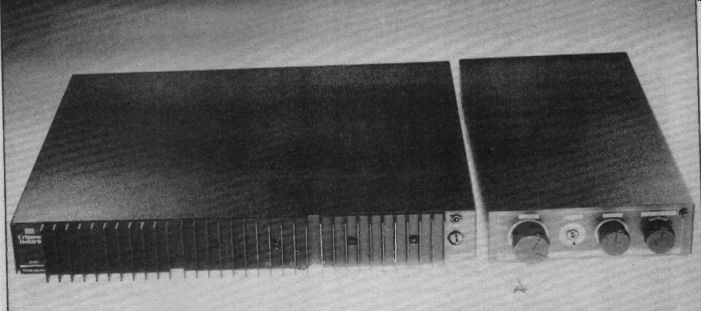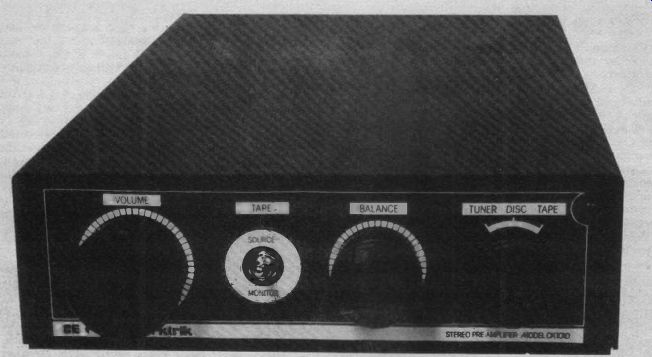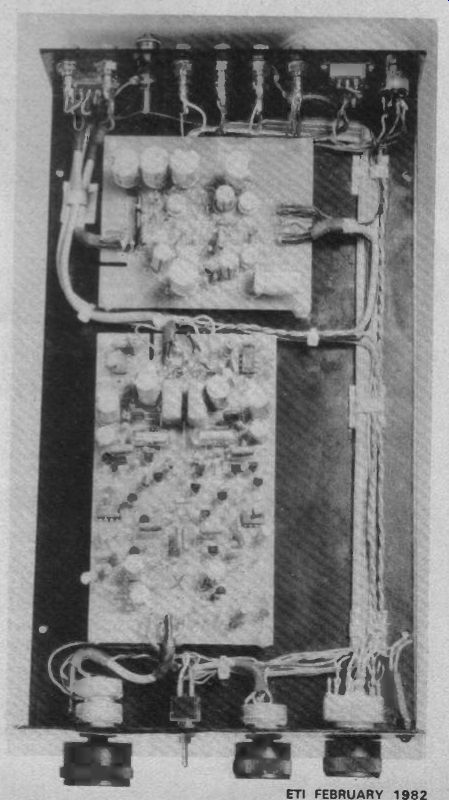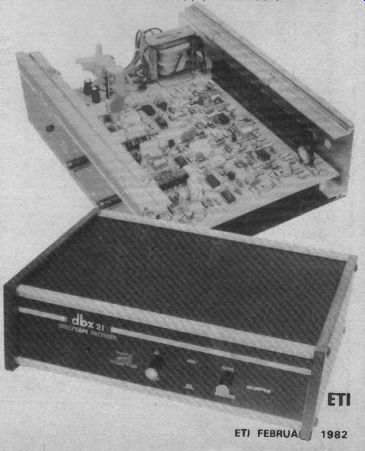
It's King Crimson time, as Ron Harris gets an exclusive first look at the new pre/power amplifier kits from our friends Elektrik.
Hello, good evening and welcome. Well, I've started Audiophile just about every other possible way known to mankind except the obvious, so why not? What do you expect for 75p anyway? Hemingway? Right, having gotten the always awkward opening out of the way, let's have at it, good readers. This month we have an EXCLUSIVE. Note the capitals! Crimson Elektrik have long been regarded as the doyens of kit-build amplifiers and a new model from them is an EVENT (note the capitals again. Connects the two together you see, psychologically speaking. Cunning things these psychs.).
This is the first review of the CK1010/CK1100 combination--the brand new Crimson Elektrik 100 W pre/power amplifier kit. These two are part of a range which also includes:
CK1040, a 40 W per channel power amplifier, costing £119
MC2K, a moving-coil preamp add-on to the CK1010 preamp, costing £25
PSK, a PSU module--needed if you use the 1010 preamp without a Crimson power amp, at £20. All prices include VAT.
Sit down at the back there please, I haven't forgotten. The CK1010 costs £90 and the CK1100 power amp will set you back £149. Also including VAT.
Ranging In
The obvious question is--why a new amp at all, if the 'old' one is so good and doing so well? Crimson say this model is spawned from the comments of users of the present range, in as much as it contains all the improvements they have been asked for that were sensible. So anyone who wanted a Paisley pat tern case to match the wallpaper has been politely ignored.
However, those who noticed how easily satin finish steel picks up--and holds--finger marks have not cast their words into a uncaring void. The new case is crinkle finished and easily cleaned!
In among the circuitry--which is new anyway--mods such as a switched sensitivity volume control have been added, in this case to facilitate use at low-level with a good range of control on the pot.
A worthy addition then, and not simply a new box and old ideas. Would that all companies restrained themselves in such a manner. Coincidentally, I think it is noticeable how the classier firms are the last to rush toward a new release, just to add a control or two. How many new Quad units have there been? Or SME?
Might be a rule in there somewhere, you know; 'Ron's Law of Inverse Quality Marketing' I could call it. Always fancied being in the history books.
CK1010 Preamp

As with all Crimson kits, the PCB arrives pre-assembled, with no soldering required on the board itself. The buyer is asked only to mount the PCB in the case, wire it up to the input and output hardware and fit the controls. Easy for such as are reading this, is it not? All the necessary bits and pieces are provided, right down to feet for the case and an aluminum facia for that professional look. The chassis itself is steel and has all the metal work done to it already. It is finished in a matt finish known as passivation--which everyone has seen and no-one knows the name of. Makes a good earth though. As I have mentioned previously, the case lid is crinkle finished both for looks and for avoidance of wear and tear.
Inputs catered for are disc, tape and tuner, with moving coil available through the MC2K option. Personally I think they should have fitted two tape inputs, but that's a personal point of view, most people would not need it--until someone turns up to record their LPs.
Controls offered are volume, balance, stereo/mono, input select, tape monitor and 10 dB attenuator (coupled to the volume control). No filters and no tone controls. (Do you really need them, or is your present amp simply bass-deficient or top-end prominent?) All outputs, except power supply, are phono socketed and quite right too, in my opinion. The only use for the dreaded DIN is to carry the output to the Crimson CK1040/CK1100 and bring back the low voltage supply.

Design Noted
The preamp falls basically into four gain 'blocks' which use both ICs and discrete transistors where applicable, to reduce noise effects in the earlier stages of the design: for example, the magnetic input is a cascode circuit employed to match the high impedance source of the cartridge.
Switching thumps are eliminated by JFET switches set at the output. All in all the 1010 is an improved version of the pre sent Crimson 'Super preamp board, using more or less the same high stability component positions designated therein. The stereo/mono switch, the attenuator and the MC/MM select switch for the phono input are all situated on the back panel of the unit, next to a sensibly huge earth terminal! The unit I had for trial was fitted with the moving-coil board already, to allow me to exercise some favorite cantilevers.
----------
TABLE 1
CK1010 Pre–amplifier
Frequency Response :
30 Hz-40 kHz +-2 dB (built-in LF filter at-12dB/octave below 20 Hz)
Pick-up input noise ratio : -70 dB (ref. 3 mV unweighted)
Moving coil input s/n ratio: -65 dB (ref. 200 nV unweighted)
Tape/tuner input :-80 dB (ref. 100 mV)
Pickup Overload : 37 dB (ref. 3 mV)
THD : 0.005%
RIAA Accuracy : +- 0.3 dB (20 Hz-20 kHz)
Price : see text
C1100 Power Amplifier
Power Output : 94 W (into 8 R) 141 W (into 4 R)
Power Bandwidth : 10 Hz – 40 kHz THD : 0.005% (any power, 20 Hz--20 kHz)
THD : un-measurably low
S/N Ratio :-120 dB (ref. 94 W into 8 R)
Price : See text
----------
CK1100 Power Amp

Power amp PSUs are something we've been going on about at some length recently, simply because they are an often overlooked area in which great improvements can be effected.
(Read the article in this very issue, for example.) Crimson have not employed two complete supplies but have adopted a very acceptable approach to the same end. A large single toroid, with two secondary windings, feeds two separate rectifier and reservoir networks, such that each channel has its own energy-store to draw upon in case of dire (peak) need.
Dynamic crosstalk will be reduced with this configuration, when compared to the more usual single supply and reservoir set-up all too common in commercial amplifiers.
Protection for the output is provided by a shut-off circuit rather than fuses in the output. A mains fuse is provided--and not even the most extreme of the 'super-ear-and-no-instruments' review brigade has suggested that makes a difference to final sound (yet?) Once again all the hardware and heatsinks etc. are pro vided in the kit and there is nothing more to spend out on, short of a mains plug. The required DIN-to-DIN lead for connections to the preamp is included with the 1010 kit. At first glance the case may seem a little large, but the heatsinks occupy a fair amount of panel length, and distancing the modules from the PSU is no bad thing. Keep your wiring neat and it will repay you with added d Bs of noise-ratio.
Overall the constructional standard of the pre-assembled boards is very high, maintaining Crimson's reputation. Assuming the builder wires them up correctly, the amps are guaranteed for two years, so be careful with the iron-overheat in haste and repent at leisure.
I would estimate that an experienced constructor could assemble a 1010, 1100 set-up in about four hours, if he makes no serious errors. Take your time and get it right the first time. Probably best to spread it over two evenings, taking one unit at a time.
As this is a kit amplifier, test results will depend to some extent upon the standard to which the kit is actually constructed. The results given herein are for a kit which has had its assembly optimized to obtain the best possible results and can thus be considered as pretty much as good as you'll get! The Crimson delivered a good all-around performance as could be expected from any amplifier of its price-or indeed, of any unit costing twice as much. It is noticeable that the output power increases some 3dB into low impedances, thus offering advantage both with difficult loads and under dynamic conditions.
Only upon the power output did the Crimson fail to meet spec.
It turned in 94 W into eight-ohms, but was capable of delivering 140+ both into 4 R continuously, or under dynamic drive conditions into 8 R. Thus the amp has an excellent "headroom" into eight ohms, for which I think we could forgive them losing six watts somewhere in the paper work.
Down to Sound
So after all that, what does the new Crimson actually sound like? In a word, good. I tried it with KEF 105 II loudspeakers most of the time, but wired in a pair of Wharfedale Laser 80s to see what it could do for a pair of less ambitious enclosures. Source equipment was a Thorens TD 160S/SME III with Dynavector Karat and Shure MV 30 HE cartridges, to test out the MC and MM boards respectively. In addition a Sony ST-J75 tuner provided some nice off-air signals, for when I grew fed-up of changing LPs! As comparative amplifiers I had the Trio KA-1000 Sigma Drive still at hand and a friend's specialist British unit, which clapped out halfway through the tests in a blaze of melting out put stages and is thus best left untamed! The Crimson proved to be a very controlled piece of hi-fi. It kept command of the bass signals superbly, never sounding loose. It has an excellent bass extension and when used with good speakers is capable of frightening levels of energy! The protection circuit never affected operation and is thus com mended.
Mid-range is open and detailed and more revealing than is first apparent, since the amp is unkind to poor quality source material--as is most top flight hi-fi.
Treble is replayed clearly and precisely with no signs of hardness, a complaint which was leveled at some earlier designs--unfairly in my view. Power is well maintained at all frequencies.
The dynamic range available through the KEFs was stunning. I had just laid hands on some dbx recordings (upon which more next month) and the Crimson really showed what it could do with these! A copy of the Police album 'Zenyatta Mondatta' was unbelievable in its dynamics. The 1100 coped with the challenge admirably, while another amp committed hara kiri in a somewhat spectacular fashion! The low noise-floor and sharpness of reproduction did the CL1010/1100 great credit.
Supply Procedure
I think the bass quality is due in no small part to the PSU design. The phono inputs too are worthy of special praise. The noise is low and there is good matching for the cartridge.
The moving-coil board is worth acquiring, as it extends the range of the Crimson at a very reasonable cost.
Overall the performance is truly outstanding for a £250 amplifier and can be considered worthy by any standards of cost or absolute performance. There is little to criticize in the sound at all and nothing of substance amiss with the kit itself.
Personally I think the volume attenuator should be on the front panel, as it is awkward to locate where it is and I would change the toggle-type tape switch for something a little more up market!--and if that's all I can find to criticize in a design, it must be good! Conclusions It would seem then that Crimson have maintained their position at the top of the commercial kit-build field. There is no Oriental amplifier I know of that can better the sound of this combination overall at any price and only a few--such as the KA-1000--are of comparable standard.
Power delivery is excellently maintained, with the result that if your speakers can take it, the 1010/1100 can go a lot louder than 100 W would suggest! Low impedances are handled smoothly and easily, so there will be no problems with 'nasty' loads I can say no more than that for £250 it is a bargain and one that becomes the reference point for kit amplifiers from now on.
Details from: Crimson Elektrik, 9 Claymill Road, Leicester LE4 7JJ
Record Time

Next month we're taking a look at dbx disc replay in more detail, as many readers had enquired about them, following Pete Green's report on the launch of their new decoder. We have also located a source of a large catalogue of these recordings and can now pass on supply information!
= = = =
Electronics Today (UK print magazine)
Also see: